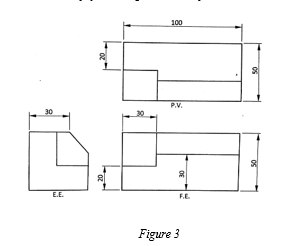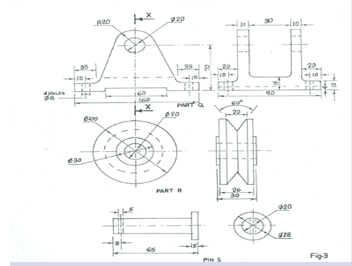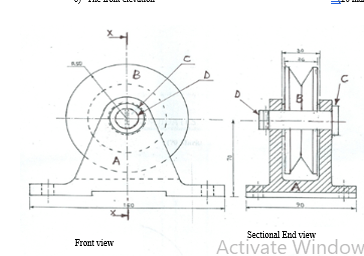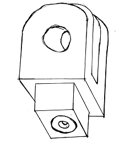Instructions
- You should have the following for this examination:
- Sufficient A4 drawing papers (to be used as answer sheet for section A)
- Drawing instruments;
- 3 sheets of drawing paper size A3;
- This paper consists of three sections: A, B and C.
- Answer all the questions in sections A and B and any other two questions from section C.
- Questions in section A must be answered on the A4 papers provided. The work must be arranged in an orderly manner.
- Questions in section B and C should be answered on A3 sheets of drawing paper provided.
- All dimensions are in millimetres unless otherwise stated.
- NUMBER your work clearly.
- Candidates may be penalized for not following the instructions given in this paper.
- This paper consists of 11 printed pages.
- Candidates should check the question paper to ascertain that all the pages are printed as
- indicated and that no questions are missing.
- Candidates should answer the questions in English.

QUESTIONS
Section A (50 marks)
-
- Give two advantages of technical drawing in the field of engineering
(2 marks) - State four parts of a computer that are needed in order to make any drawing using a computer. State one purpose of each part. (2 marks)
- Give two advantages of technical drawing in the field of engineering
-
-
- State the method of sharpening a pencil suitable when you want to perform the following (2 marks)
- Drawing fine and thick line
- Drawing accurate lines
- Sketching and lettering
- Drawing a circle
- Outline how a pencil should be positioned when used with knee joint pair of
compasses (1 mark)
- State the method of sharpening a pencil suitable when you want to perform the following (2 marks)
- Sketch the symbols used for the following conventions in drawing:
- Screwed joint.
- External screw thread (3 marks)
-
-
- Give four reasons why metals are preferred in design of heavy machines and objects. (2 marks)
- List four components of a business plan (2 marks)
- Define each of the following terms as used in the design process; (2 marks)
- Primary objective
- Aesthetics
- Construct the involute of a pentagon of sides 20 mm (5 marks)
- Figure 1 shows a block drawn in isometric projection. Draw in good proportion the following views in third angle projection: (7 marks)
- The front elevation
- The plan.

Figure 1
- Figure 2 shows an elevation and an incomplete plan of a truncated rectangular pyramid drawn in first angle projection. (4 marks)
- Copy the elevation
- Complete the plan

Figure 2
- Figure 3 shows three views of a shaped block drawn in third angle projection. Draw the block in isometric projection taking X as the lowest point. (6 marks)

Figure 3 - Illustrate methods of dimensioning each of the following features: (6 marks)
- Small circles
- Reflex angles
- Arcs
- Small gaps
- Figure 4 shows an exploded view of a joint. Assemble the parts and draw full size the three orthographic views of the joint in third angle projection. (6 marks)

Figure 4
SECTION B (20 marks)
This question is compulsory
It should be answered on the A3 paper provided.
Candidates are advised to spend not more than 1 hour on this question.
- Figure 5 shows the parts of a pulley wheel system drawn in first angle projection. Assemble the parts and draw Full Size the following:
- A sectional end elevation.
- The front elevation (20 marks)

Figure 5
SECTION C (30 marks)
Answer any two questions from this section on the A3 paper provided.
- Figure 6 shows a cone truncated at the top and bottom. Copy the figure and draw the surface development of the cone. (15 marks)

Figure 6 - Figure 7 shows the front view of a house. Construct a diagonal scale in which 20 mm represent 1 m to read up to 8 m.
Use the scale to draw the view of the house. (15 marks)
Figure 7 - Figure 8 shows three orthographic views of a block drawn in first angle orthographic projection.

Figure 8
Draw the isometric view of the block. Include hidden details. (15 marks)

MARLING SCHEME
Section A (50 marks)
-
- Give two advantages of technical drawing in the field of engineering (2 marks)
- It enables engineers to be more accurate.
- It enables engineers to know the actual size and shape of the object.
- It enables engineers to plan their work on papers hence improve their speed.
- It equips engineers with variety of techniques which are needed to solve a particular problem. Any two correct answers 1 each=2
- State four parts of a computer that are needed in order to make any drawing using a computer. State one purpose of each part. (2 marks)
- Monitor- for display
- Mouse- for moving the cursor to desired positions.
- Central Processing Unit- it processes instructions and handles calculations and other logical operations of the computer.
- Keyboard- it is used for putting information including letters, words and numbers into a computer. 4x½= 2
- Give two advantages of technical drawing in the field of engineering (2 marks)
-
-
- State the method of sharpening a pencil suitable when you want to perform the following (2 marks)
- Drawing fine and thick line – Chisel shape
- Drawing accurate lines- conical point
- Sketching and lettering- conical point
- Drawing a circle- chisel shape each method x½=2
- Outline how a pencil should be positioned when using a knee joint pair of compasses. (1 mark)
- The pencil and needle should be kept perpendicular to the paper.√1
- State the method of sharpening a pencil suitable when you want to perform the following (2 marks)
- Sketch the symbols used for the following conventions in drawing:
- Screwed joint.

Correct symbol =1½ - External screw thread (3 marks)

Correct symbol=1½
- Screwed joint.
-
-
- Give four reasons why metals are preferred in design of heavy machines and objects. (2 marks)
- They are resistant to extreme temperatures e.g carbon alloys.
- They are resistant corrosion e.g copper
- They conduct heat and electricity e.g aluminium and copper
- They have high tensile strength e.g steel 4 reasons x½=2
- List four components of a business plan (2 marks)
- Name of the business
- The product or services to be offered.
- Human resources needed
- The market to serve
- Summary of the plan. 4 components x½=2
- Give four reasons why metals are preferred in design of heavy machines and objects. (2 marks)
- Define each of the following terms as used in the design process; (2 marks)
- Primary objective
It is an objective of a design that solves the problem it is intended for. √1 - Aesthetics
This refers to the appearance of the final object.√1
- Primary objective
- Construct the involute of a pentagon of sides 20 mm (5 marks)

Pentagon=1½
Linework=2
Path forming an invoute=1½ - Figure 1 shows a block drawn in isometric projection. Draw in good proportion the following views in third angle projection: (7 marks)
- The front elevation
- The plan.

3rd angle projection=½
Proportional=½
3 faces on front elevation=1½
Hidden details=1½
6 faces on the plan=3
- Figure 2 shows an elevation and an incomplete plan of a truncated rectangular pyramid drawn in first angle projection. (4 marks)
- Copy the elevation
- Complete the plan
Copying the elevation=1
Linework=2
Completing the plan=1
- Figure 3 shows three views of a shaped block drawn in third angle projection. Draw the block in isometric projection taking X as the lowest point. (6 marks)

Isometric=½
Point X as the lowest point=½
5 faces on the object=2½
Dimensioning=2
Neatness=½ - Illustrate methods of dimensioning each of the following features: (6 marks)
- Small circles
- Reflex angles
- Arcs
- Small gaps

Small circle=1½
Reflex angle=1½
Arcs=1½
Small gaps=1½
- Figure 4 shows an exploded view of a joint. Assemble the parts and draw full size the three orthographic views of the joint in third angle projection. (6 marks)

3rd angle projection=½
Direction=½
3 faces on front view=1½
3 faces on end view=1½
Plan=1
Hidden details=1
SECTION B (20 marks)
This question is compulsory
It should be answered on the A3 paper provided.
Candidates are advised to spend not more than 1 hour on this question.
- Figure 5 shows the parts of a pulley wheel system drawn in first angle projection. Assemble the parts and draw Full Size the following:
- A sectional end elevation.
- The front elevation (20 marks)

Sectional front view End view
Assembling three parts 3x2=6 Overall dimensions=2 copying=3
Hatching wheel and frame=2 Hidden details not shown=1 Wheel shown on frame=2
Pin not hatched=1 Head of pin shown=1
Locking pin using pin=1 Neatness=1
SECTION C (30 marks)
Answer any two questions from this section on the A3 paper provided.
- Figure 6 shows a cone truncated at the top and bottom. Copy the figure and draw the surface development of the cone. (15 marks)

Copying=2
Drawing and dividing circle=1
Linework=7
Development=3
Neatness=2 - Figure 7 shows the front view of a house. Construct a diagonal scale in which 20 mm represent 1 m to read up to 8 m.
Use the scale to draw the view of the house. (15 marks)

Actual length=1
Major scale=2
Diagonal scale=2
Should be drawn using reading from diagonal scale. Construction arc must be available
Frame=1½
Door=2½
Two windows=4
Neatness=2 - Figure 8 shows three orthographic views of a block drawn in first angle orthographic projection.

Isometric=½
6 faces 6x½=3
Circular features=6
Dimensioning=2½
Hidden details included=2
Neatness=1
Draw the isometric view of the block. Include hidden details. (15 marks)
Download Drawing And Design Paper 1 Questions and Answers - Nginda Girls Mock Examination 2023.
Tap Here to Download for 50/-
Get on WhatsApp for 50/-
Why download?
- ✔ To read offline at any time.
- ✔ To Print at your convenience
- ✔ Share Easily with Friends / Students
